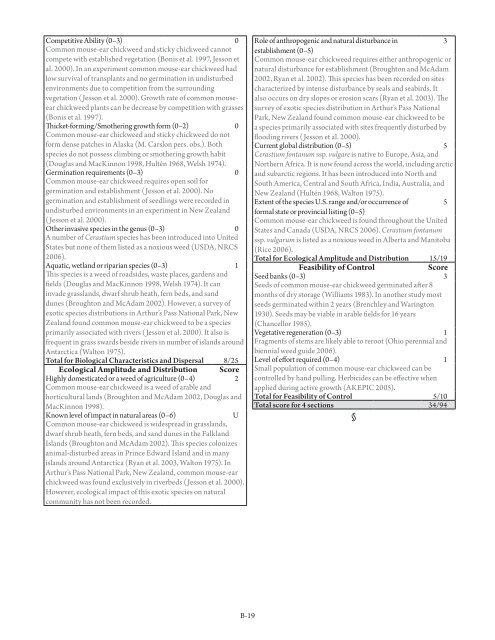Invasiveness Ranking System for Non-Native Plants of Alaska
Invasiveness Ranking System for Non-Native Plants of Alaska
Invasiveness Ranking System for Non-Native Plants of Alaska
Create successful ePaper yourself
Turn your PDF publications into a flip-book with our unique Google optimized e-Paper software.
Competitive Ability (0–3) 0Common mouse-ear chickweed and sticky chickweed cannotcompete with established vegetation (Bonis et al. 1997, Jesson etal. 2000). In an experiment common mouse-ear chickweed hadlow survival <strong>of</strong> transplants and no germination in undisturbedenvironments due to competition from the surroundingvegetation (Jesson et al. 2000). Growth rate <strong>of</strong> common mouseearchickweed plants can be decrease by competition with grasses(Bonis et al. 1997).Thicket-<strong>for</strong>ming/Smothering growth <strong>for</strong>m (0–2) 0Common mouse-ear chickweed and sticky chickweed do not<strong>for</strong>m dense patches in <strong>Alaska</strong> (M. Carslon pers. obs.). Bothspecies do not possess climbing or smothering growth habit(Douglas and MacKinnon 1998, Hultén 1968, Welsh 1974).Germination requirements (0–3) 0Common mouse-ear chickweed requires open soil <strong>for</strong>germination and establishment (Jesson et al. 2000). Nogermination and establishment <strong>of</strong> seedlings were recorded inundisturbed environments in an experiment in New Zealand(Jesson et al. 2000).Other invasive species in the genus (0–3) 0A number <strong>of</strong> Cerastium species has been introduced into UnitedStates but none <strong>of</strong> them listed as a noxious weed (USDA, NRCS2006).Aquatic, wetland or riparian species (0–3) 1This species is a weed <strong>of</strong> roadsides, waste places, gardens andfields (Douglas and MacKinnon 1998, Welsh 1974). It caninvade grasslands, dwarf shrub heath, fern beds, and sanddunes (Broughton and McAdam 2002). However, a survey <strong>of</strong>exotic species distributions in Arthur’s Pass National Park, NewZealand found common mouse-ear chickweed to be a speciesprimarily associated with rivers (Jesson et al. 2000). It also isfrequent in grass swards beside rivers in number <strong>of</strong> islands aroundAntarctica (Walton 1975).Total <strong>for</strong> Biological Characteristics and Dispersal 8/25Ecological Amplitude and Distribution ScoreHighly domesticated or a weed <strong>of</strong> agriculture (0–4) 2Common mouse-ear chickweed is a weed <strong>of</strong> arable andhorticultural lands (Broughton and McAdam 2002, Douglas andMacKinnon 1998).Known level <strong>of</strong> impact in natural areas (0–6)UCommon mouse-ear chickweed is widespread in grasslands,dwarf shrub heath, fern beds, and sand dunes in the FalklandIslands (Broughton and McAdam 2002). This species colonizesanimal-disturbed areas in Prince Edward Island and in manyislands around Antarctica (Ryan et al. 2003, Walton 1975). InArthur’s Pass National Park, New Zealand, common mouse-earchickweed was found exclusively in riverbeds (Jesson et al. 2000).However, ecological impact <strong>of</strong> this exotic species on naturalcommunity has not been recorded.Role <strong>of</strong> anthropogenic and natural disturbance in3establishment (0–5)Common mouse-ear chickweed requires either anthropogenic ornatural disturbance <strong>for</strong> establishment (Broughton and McAdam2002, Ryan et al. 2002). This species has been recorded on sitescharacterized by intense disturbance by seals and seabirds. Italso occurs on dry slopes or erosion scars (Ryan et al. 2003). Thesurvey <strong>of</strong> exotic species distribution in Arthur’s Pass NationalPark, New Zealand found common mouse-ear chickweed to bea species primarily associated with sites frequently disturbed byflooding rivers (Jesson et al. 2000).Current global distribution (0–5) 5Cerastium fontanum ssp. vulgare is native to Europe, Asia, andNorthern Africa. It is now found across the world, including arcticand subarctic regions. It has been introduced into North andSouth America, Central and South Africa, India, Australia, andNew Zealand (Hultén 1968, Walton 1975).Extent <strong>of</strong> the species U.S. range and/or occurrence <strong>of</strong>5<strong>for</strong>mal state or provincial listing (0–5)Common mouse-ear chickweed is found throughout the UnitedStates and Canada (USDA, NRCS 2006). Cerastium fontanumssp. vulgarum is listed as a noxious weed in Alberta and Manitoba(Rice 2006).Total <strong>for</strong> Ecological Amplitude and Distribution 15/19Feasibility <strong>of</strong> ControlScoreSeed banks (0–3) 3Seeds <strong>of</strong> common mouse-ear chickweed germinated after 8months <strong>of</strong> dry storage (Williams 1983). In another study mostseeds germinated within 2 years (Brenchley and Warington1930). Seeds may be viable in arable fields <strong>for</strong> 16 years(Chancellor 1985).Vegetative regeneration (0–3) 1Fragments <strong>of</strong> stems are likely able to reroot (Ohio perennial andbiennial weed guide 2006).Level <strong>of</strong> ef<strong>for</strong>t required (0–4) 1Small population <strong>of</strong> common mouse-ear chickweed can becontrolled by hand pulling. Herbicides can be effective whenapplied during active growth (AKEPIC 2005).Total <strong>for</strong> Feasibility <strong>of</strong> Control 5/10Total score <strong>for</strong> 4 sections 34/94§B-19
















